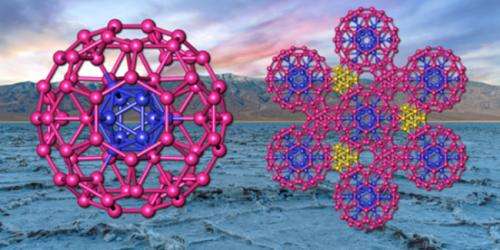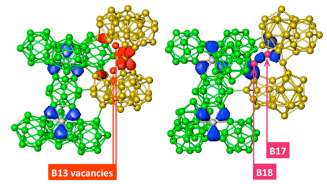New insights into boron's chemistry at room temperature

(Phys.org) —Livermore researchers have described in detail the properties of the room temperature form of the element boron.
In the periodic table, boron occupies a peculiar, transitional position. It sits on the first row, and has metallic elements to its left, and non-metals to its right. Furthermore, it is the only non-metal in the third column of the periodic table.
It is not surprising that the crystallographic structure and topology of boron's stable form at room temperature (β-boron) are not shared by any other element, and are extremely complex. The formidable intricacy of β-boron, characterized by interconnecting icosahedra (a regular polyhedron with 20 identical equilateral triangular faces) partially occupied sites, and an unusually large number of atoms per unit cell (more than 300), has been known for more than 40 years.

Boron remains the only element purified in macroscopic quantities for which the ground state geometry has not been completely determined by experiments. Theoretical progress over the last decade has shed light on numerous properties of elemental boron, leading to a thorough characterization of its structure at ambient conditions, as well as of its electronic and thermodynamic properties.
In the March 8 online edition of Chemical Reviews, LLNL researchers Tadashi Ogitsu and Eric Schwegler along with Giulia Galli of University of California, Davis, discuss in detail starting from the history of boron research, and the properties of β-boron, as inferred from experiments and the ab-initio theories developed over the last decade.
More information: To read the full research article, go tohere.
Provided by Lawrence Livermore National Laboratory


















